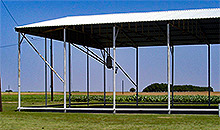Main Menu
Knox County Data
Knox County Communities & Places
Genealogy & History Links by USGHN
Important Knox County Addresses
Sponsors
Knox County Neighbors
Baylor County, Texas Genealogy & History Network
Foard County, Texas Genealogy & History Network
Haskell County, Texas Genealogy & History Network
King County, Texas
Stonewall County, Texas
Throckmorton County, Texas
Other Websites
Welcome to Knox County Texas Genealogy & History Network!
Welcome to the Knox County, Texas Genealogy & History Network. Our purpose is to provide visitors with free resources for genealogical and historical research. To share your genealogy or history information, send an email to txghn@outlook.com and we will happily include it here. For other Texas Counties, visit the Texas Genealogy & History Network state website and go to the appropriate county. Thanks for visiting and good luck with your research! |
|
About Knox County, Texas...

Knox County is in the Rolling Plains region of northwest central Texas, about seventy-five miles north of Abilene. The county was named for Henry Knox, the secretary of war in George Washington's first cabinet. Two railroad lines, owned by the Santa Fe and Burlington Northern companies, serve the county.
Until the late nineteenth century, the area now known as Knox County was frequented by nomadic Indians who followed the herds of buffalo that roamed the region. In Spanish and Mexican Texas, several copper deposits along the Brazos were reportedly mined by Spaniards using Indian conscripts as laborers. The first white to penetrate the future county area was probably Capt. Randolph B. Marcy, who in 1854 traveled through the area to survey the Brazos and Wichita valleys while searching for a suitable site for an Indian reservation. In 1855 elements of the Second United States Cavalry, commanded by colonels Albert Sidney Johnston and Robert E. Lee, patrolled the vicinity.
 In February 1858 the Texas legislature formed Knox County from lands formerly assigned to Young and Bexar counties; because the area remained unsettled, it was again decreed a county in 1876 and attached to Baylor County in 1879 for administrative purposes. In 1880 only three farms or ranches were in operation in the county. Settlers came in larger numbers between 1880 and 1900. Robert D. Goree, who came as a cattleman to Northwest Texas in 1882, opened up the land to agriculture by encouraging people from older states and other Texas counties to move into Knox County. The county was organized in 1886, with the town of Benjamin, founded by Hillary Bedford in 1884 and named for his oldest son, as county seat. The first courthouse, a small box-and-strip building, was replaced by a native stone structure in 1888. By 1887 Goree had established a small settlement that he named after himself at Riley Springs, in the southeastern part of the county, and in 1895 a colony of German Catholics established the town of Rhineland a few miles away. Several ranchers, including Robert B. Masterson, Tom (William Thomas) Waggoner, W. R. McFadden,
In February 1858 the Texas legislature formed Knox County from lands formerly assigned to Young and Bexar counties; because the area remained unsettled, it was again decreed a county in 1876 and attached to Baylor County in 1879 for administrative purposes. In 1880 only three farms or ranches were in operation in the county. Settlers came in larger numbers between 1880 and 1900. Robert D. Goree, who came as a cattleman to Northwest Texas in 1882, opened up the land to agriculture by encouraging people from older states and other Texas counties to move into Knox County. The county was organized in 1886, with the town of Benjamin, founded by Hillary Bedford in 1884 and named for his oldest son, as county seat. The first courthouse, a small box-and-strip building, was replaced by a native stone structure in 1888. By 1887 Goree had established a small settlement that he named after himself at Riley Springs, in the southeastern part of the county, and in 1895 a colony of German Catholics established the town of Rhineland a few miles away. Several ranchers, including Robert B. Masterson, Tom (William Thomas) Waggoner, W. R. McFadden,  and J. C. Teague, had all or part of their ranges in the county. By 1890 there were seventy-six farms and ranches in the county, and by 1900 there were 366, encompassing about 449,000 acres.
and J. C. Teague, had all or part of their ranges in the county. By 1890 there were seventy-six farms and ranches in the county, and by 1900 there were 366, encompassing about 449,000 acres.
Further movement to Knox County was encouraged during the first years of the twentieth century, when two railroads built their tracks into the area. In 1905 the Wichita Valley Railroad entered the county; the Kansas City, Mexico and Orient line followed suit in 1907. By 1910 the county had 1,175 farms and ranches. Corn was planted on almost 25,000 acres by that time, and cotton on more than 36,000 acres. Meanwhile, wheat production also increased, and Knox County farmers were diversifying into fruit and poultry production. By 1910 more than 33,000 fruit trees (mostly peach) had been planted in the county, and almost 41,000 fowl were reported on local farms.
Between 1910 and 1920 some of the earlier settlers were shaken out, as the number of farms dropped to 1,037 by 1920. The county grew again during the 1920s, however, largely because of a continuing cotton  boom. Between 1910 and 1929 corn and wheat culture increasingly gave way to cotton culture, which became the center of the local agricultural economy. In 1919 53,645 acres was planted in cotton, and by 1930 production of the fiber had expanded to 130,247 acres. By 1930 there were 1,460 farms in Knox County. But Knox County agriculture suffered serious setbacks during the Great Depression and the Dust Bowl. Cotton production plunged more than 50 percent, and by 1940 only 67,584 acres was planted in the fiber. About a third of the county's farmers left their lands during this period; by 1940 only 980 farms remained.
boom. Between 1910 and 1929 corn and wheat culture increasingly gave way to cotton culture, which became the center of the local agricultural economy. In 1919 53,645 acres was planted in cotton, and by 1930 production of the fiber had expanded to 130,247 acres. By 1930 there were 1,460 farms in Knox County. But Knox County agriculture suffered serious setbacks during the Great Depression and the Dust Bowl. Cotton production plunged more than 50 percent, and by 1940 only 67,584 acres was planted in the fiber. About a third of the county's farmers left their lands during this period; by 1940 only 980 farms remained.
Oil was discovered in Knox County in 1945. By 1946 the county's first successful oil well had been spudded on the Beavers Ranch, north of Benjamin; in subsequent years other wells were drilled in the southern part of the county. In 1948 oil production was only thirty-seven barrels, but in 1956 it reached 978,715, and in 1960, almost 2,415,000. County oil wells produced 2,065,000 barrels in 1965, 771,089 barrels in 1974, and 1,421,964 barrels in 1982. Almost 55,881,000 barrels had been taken from Knox County lands since discovery in 1945.

The county has a total area of 855 square miles, of which 850 square miles is land and 5 square miles (0.6%) is water. The population recorded in the 1880 Federal Census was 77. It peaked in 1930 at 11,368. The 2010 census recorded 3,719 residents in the county.
Neighboring counties are Foard County (north), Baylor County (east), Haskell County (south), King County (west), and Stonewall County (southwest). The county seat is Benjamin. Other communities in the county include Goree, Knox City, Munday, Rhineland, Truscott, and Vera.
Knox County, Texas Records
Birth Records - The Texas Department of State Health Services has records from 1903 to present. Records for the last 75 years considered private and will only be provided to certain individuals. To obtain current information on who may obtain a record, how to submit a request and an official request form, see the Texas Department of State Health Services website or write to Texas Vital Records, Department of State Health Services, P.O. Box 12040, Austin, TX 78711-2040.
For older birth records you will have to write to the County Clerk of the applicable county. The existence of birth records prior to 1903 will vary widely from county to county. Local historical societies and genealogy collections in local libraries may be able to provide some information.
Death Records - The Texas Department of State Health Services has records from 1903 to present. Records for the last 25 years considered private and will only be provided to certain individuals. To obtain current information on who may obtain a record, how to submit a request and an official request form, see the Texas Department of State Health Services website or write to Texas Vital Records, Department of State Health Services, P.O. Box 12040, Austin, TX 78711-2040.
Marriage Records - The Texas Department of State Health Services can provide a verification letter of marriage for Texas marriages from 1966 to present. This is NOT a marriage license. To obtain a certified copy of a marriage license you must contact the County or District Clerk in the county or district where the marriage took place.
Local historical societies and genealogy collections in local libraries may be able to provide some information.
Divorce Records - The Texas Department of State Health Services can provide a verification letter of divorce for Texas divorces from 1968 to present. This is NOT a copy of the divorce decree. To obtain a certified copy of a copy of the divorce decree you must contact the County or District Clerk in the county or district where the divorce took place.
Local historical societies and genealogy collections in local libraries may be able to provide some information.




